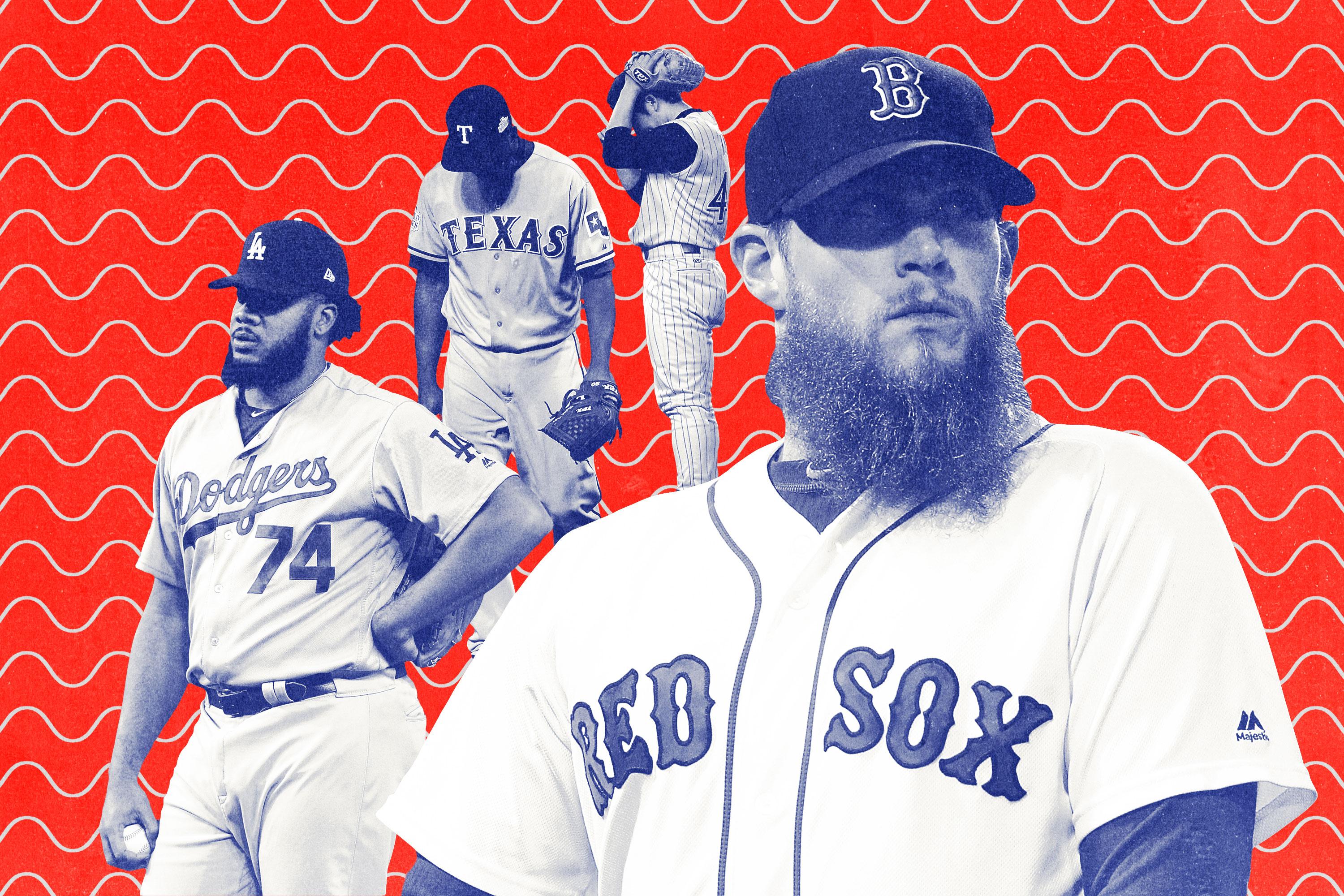
One of the best parts of Game 5 of the ALCS for Boston fans was one of the worst for casual baseball viewers. It wasn’t just that Boston’s 4-1 victory against Houston deprived the sport of more games between 100-win teams (which was also deflating) or that Boston is now the favorite to win its fourth title in 15 seasons (gross)—it was that for the first time in these playoffs, Craig Kimbrel completed a comfortable save.
Entering October, the collective wisdom suggested that the Red Sox should be worried about all of their relievers other than their closer, but that perception flipped through Boston’s first two series. Counting starters who pitched in relief, Boston’s non-Kimbrel relievers combined for a 2.90 ERA in 31 innings, while Kimbrel looked less like the closer with the best-ever era-adjusted ERA for a pitcher with at least 500 career innings and more like Nuke LaLoosh with an unfortunate beard.
In Kimbrel’s first four appearances in the playoffs, all save opportunities, Aaron Judge homered, Gary Sánchez nearly hit a game-winning grand slam, and Alex Bregman almost erased Boston’s ninth-inning lead in two different games. Kimbrel amassed an 8.44 ERA and allowed an OPS north of 1.000, as 13 of 28 batters he faced reached base via a walk, hit, or hit by pitch, yet he somehow escaped all four games with successfully converted saves. He was a one-man roller coaster, and playoff watchers couldn’t help but be excited—and Red Sox fans anxious—for their next time through the ride.
And then in Game 5, Kimbrel permitted just one walk in an otherwise clean inning, and he didn’t allow a run for the first time this month. Perhaps he stopped tipping pitches—even if that explanation seems a bit too tidy, given that tipping wasn’t the reason Kimbrel kept missing the strike zone by multiple feet at a time—or perhaps the law of averages meant he was bound for one easy night out of five. Kimbrel is one of the most effective closers in history, and we should expect that he’ll pitch to that lofty level going forward, as Boston enters its World Series matchup against the Dodgers.
Which is a darn shame, because the best way to produce a dramatic playoff series is for its closers to combust on a nightly basis. Deriving increased enjoyment from a human being’s failure seems harsh, but it’s borne out by history and math; every year, baseball teams win about 95 percent of the games they lead entering the ninth inning, but the games we remember tend to come from the other 5 percent—that small sliver in which favorites falter, narratives reverse, and unforgettable highlights emerge.
There are plenty of ways a reliever can make a game more exciting, but for simplicity’s sake, let’s focus on when he blows a save, because even that one category provides a wealth of examples to prove the broader point. In the offseason between the 2010 and 2011 seasons, MLB Network ranked the top 20 games since the 1960 World Series, when Bill Mazeroski’s home run won Game 7 for the Pirates. More than half involved blown saves. (Mazeroski, by the way, batted after blown saves in both the bottom of the eighth and top of the ninth.)
In order, per MLB Network’s list, the following iconic playoff moments either followed or created a blown save: Carlton Fisk’s homer; Bill Buckner’s gaffe; Francisco Cabrera’s single; the Mets’ beating the Astros in 16 innings; Dave Henderson’s homer; Luis Gonzalez’s single; Kirk Gibson’s homer; Derek Jeter becoming Mr. November; the Marlins winning the 1997 World Series; Joe Carter’s homer; the Red Sox beginning their comeback in the 2004 ALCS; and the 1980 Phillies and Astros dueling in their NLCS decider.
Another game from that MLB Network list—Marlins-Giants Game 4 in the 2003 NLDS—is remembered mainly for its near-blown save, and yet another—Game 163 between the Tigers and Twins in 2009—saw Fernando Rodney blow a 10th-inning lead after entering a tie game the previous inning.
And since MLB Network created its list, the games that stand out as all-timers continue this pattern. The David Freese epic in the 2011 World Series might be the greatest ever; that game featured a few blown saves from Texas. The Athletics lost leads in the ninth and 12th innings in the 2014 wild-card game. Game 7 of the 2016 World Series elevated from narratively important to instantly classic when Rajai Davis homered off Aroldis Chapman. Both prominent games from last year’s World Series—2 and 5—involved ninth-inning (and, for the former, 10th-inning) comebacks.
Zooming in on the World Series, we find that since the 1994 strike, there is almost a direct correlation between how memorable a World Series is and whether it featured at least one blown save in the ninth inning or later. Here’s the full list:
- 2017: L.A.’s Kenley Jansen in Game 2, Houston’s Chris Devenski in Game 5
- 2016: None (but Chicago’s Aroldis Chapman notably blew an eighth-inning save in Game 7)
- 2015: New York’s Jeurys Familia in Games 1 and 5
- 2014: None
- 2013: None
- 2012: None
- 2011: St. Louis’s Arthur Rhodes in Game 2, Texas’s Neftalí Feliz and Scott Feldman in Game 6
- 2010: None
- 2009: None
- 2008: None
- 2007: None
- 2006: None
- 2005: Chicago’s Bobby Jenks in Game 2
- 2004: None
- 2003: Florida’s Ugueth Urbina in Game 4
- 2002: None (but San Francisco’s Robb Nen notably blew an eighth-inning save in Game 6)
- 2001: Arizona’s Byung-Hyun Kim in Games 4 and 5, New York’s Mariano Rivera in Game 7
- 2000: New York Mets’ Armando Benítez in Game 1
- 1999: None
- 1998: None
- 1997: Cleveland’s José Mesa in Game 7
- 1996: None
- 1995: None
Between 2005 (when Jenks blew a Game 2 save for the White Sox in the Scott Podsednik game) and 2015 (when Familia blew saves in Games 1 and 5 via a pair of memorable highlights), only one World Series featured a ninth-inning blown save. That series, of course, rates among the best ever, and not coincidentally, its blown-save-free neighbors are much more forgettable. Even the second-best Fall Classic between 2005 and 2015—2014’s Giants win—is memorable mainly because the winning team tried something different in the ninth inning of its Game 7 triumph than simply hand the ball to a dominant closer.
The relationship isn’t so direct in earlier playoff rounds, but still, many of the enduring moments of recent playoff baseball involve a blown save, from Boston’s 2004 ALCS romp, to Albert Pujols’s colossal home run off Brad Lidge, to the Cardinals’ comeback against Drew Storen in Game 5 of the 2012 NLDS.
This connection exists because of how we watch sports and what we seek from any game, particularly a playoff game that comes with ready-made, elevated stakes. Reliever struggles satisfy the obvious demand of late-game tension, but they also fit the athletic ideal that The Ringer’s Danny Kelly described when writing about football two years ago: “Scoring is fun. Scoring is exciting”—but that’s truest when “scoring [isn’t] too easy.”
Reversing a late-game deficit requires an injection of offense, yes, but it’s more than that—it also needs the surmounting of steep odds, which exist when any worthwhile MLB pitcher is on the mound in the late innings, and grow only steeper when an elite closer enters. Conquering someone near Kimbrel’s level in the World Series automatically produces indelible memories, as happened when Jansen and Chapman faltered in the two most recent Fall Classics. Rivera blew just one World Series save in his career—he ran a 0.99 ERA in that round—but that series is by far the most memorable of the Yankees’ title trips since the strike, in large part because it included not just Rivera’s blown save, but two Byung-Hyun Kim collapses as well.
We can also try to quantify the effect of reliever struggles on a given game’s excitement using win probability added. Each play in a game shifts a team’s win expectancy, sometimes by a great deal (Freese’s triple in 2011 boosted the Cardinals’ odds of winning Game 6 by 54 percentage points) and sometimes by an insubstantial margin (as in the case of the last out of a lopsided game). By adding up all the small changes over the course of a game, we can gain a sense of how exciting it was. Since 1995, the most exciting playoff games by their WPA sums are the expected suspects—the Freese game, the Edgar Martínez game—and the least exciting are, fittingly, contests that left few lasting impressions on the casual viewer: the Braves’ 15-0 win in Game 7 of the 1996 NLCS, the Royals’ 10-0 win in Game 6 against the Giants, and so on.
Overlaying the list of all blown saves in the postseason since 1995 on top of this WPA list yields a fascinating result: Adjusted for margin of victory, the average playoff game with a blown save is 45 percent more exciting than the average game without. In other words, if spectators knew before a game started that it would end as a one-run contest and include a blown save, they should prepare for 45 percent more excitement than if they knew it would end as a one-run contest without a blown save. That’s a huge difference, even though that result just factors in blown saves, so it doesn’t account for, say, how Kimbrel made his first four games more compelling even without losing the lead.
Let’s imagine that Kimbrel had done his job as ably as possible and completed each of his postseason saves without allowing a run. Here, then, would be the scores of Boston’s nine playoff games thus far: 5-3, 6-2, 16-1, 4-1, 7-2, 7-4, 8-2, 8-5, 4-1. That edited list includes no one-run games and only one two-run game—not quite the thrills that baseball fans crave in October. Kimbrel has single-handedly—with his single, wild right hand—transformed Boston’s playoff run from the indomitable march of a 108-win MLB titan to a nightly drama. He amplified the games’ entertainment even beyond just his own innings, as every contest induced questions of whether Boston could build a sufficient lead to avoid its closer; and if not, whether Kimbrel was warming up; and if he was, whether Alex Cora would need to leave a capable reliever in reserve just in case his man couldn’t finish the job.
In the aggregate, neither the Dodgers nor Red Sox seem like the kinds of teams that would encourage such questions, or the kind of dopamine rush and instant nostalgia brought on by a bullpen blow-up. Both pens have pitched relatively well in the playoffs, and though their respective closers have evinced October struggles before, Jansen and Kimbrel have the two best strikeout rates in MLB history (minimum 500 innings), and they’ve each made the last three All-Star rosters.
However, Jansen also suffered his worst regular season in 2018 (both before and after he went on the disabled list for an irregular heartbeat), and Kimbrel was so wild that he inspired a Nuke LaLoosh comparison earlier in this column. They’re not likely to blow any World Series lead, let alone several, but that improbability would make any stumble all the more rewarding for viewers. Let Kimbrel start tipping his pitches again; let his breaking balls burrow into the dirt and his fastballs find the barrels of bats. The first Red Sox–Dodgers World Series in more than 100 years is already alluring, but there’s a tried-and-true method to make it even more entertaining.


